FISHING LURES FOR BASS
In my tackle box, I keep only a few types of lures, but several variations of each lure.
I can narrow it down to four kinds: Top Water Poppers, Spoons/spinner/Crank Baits Diving Fish and worms.
Which one I choose on any given day depends on the water I am fishing. For example, Fort Bragg Lakes have a lot of submerged logs, stumps and vegetation. You can use a lure that goes beneath the surface, but you will often snag a lot of vegetation or worse yet get it hung up on a log and lose it. At Fort Bragg or water that has a lot of obstacles, I use top water poppers.
TOP WATER POPPERS
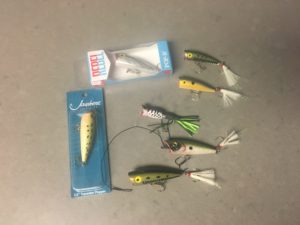
I learned how to fish poppers on the Swatara Creek in Lebanon County PA. The action of the popper convinces a fish that the lure is a small fish in distress on the surface. In many cases, the fish strikes out of being territorial. Most of the strikes take place within the first three tugs after hitting the water. BUT, be patient and continue to reel in the lure using tugs. I have caught fish as close as three feet from the boat or shore. The lessons I learned fishing for small mouth bass in PA apply all over for bass.
Basic action is to cast and let it sit for a bit. Normally long enough for the ripples to stop and disperse. Jerk the line enough to create a splash, let sit and repeat. I randomly change the amount of time I wait between tugs.
SPOONS / SPINNERS / CRANK BAITS
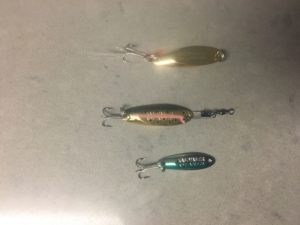
These lures are cast and retrieved creating the action of bait fish with flashes and disturbing the water beneath the surface. Try different retrieval tactics. Jerks and changes in speed can attract a strike. Like Poppers territorial fish will strike early. Cast Master makes a solid hunk of metal that flashes as it goes.

Rooster Tails have a metal spinner/blade that twirls.
Crank Baits have a small worm or jig attached to a vee shaped bar and the other leg of the vee is attached to a spinner the line is attached at the apex of the vee. The advantage of a crank bait is that it is difficult to get snagged since the hook faces the inside to avoid digging into obstacles. However, it is possible to lose crankbaits to snags.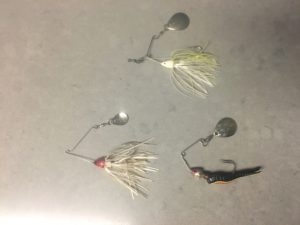
Diving lures are fish are carved or molded out of a material that floats and has a spoon sticking out of the head end of the lure. This spoon cuts into the water and forces the fish to dive or wiggle. This lure is very susceptible to getting snagged on the bottom, rocks, logs and vegetation.
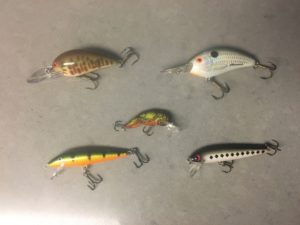
You can simply cast and retrieve. If the lure is buoyant enough to float, it can be brought back in three or four cranks at a time and allowing the lure to float. This gives the fish the impression of a small fish in distress. Pickerel will strike early and with violence. If you are in waters that contain pickerel or pike, use a 6” – 12” leader of wire cable or 50 pound test monofilm.
DIVING FISH (RAPALA) https://www.rapala.com/rapala-lures/
ARTIFICIAL WORMS
Rubber worms were a mystery to me for years/decades. The lowly rubber worm has made a lot of advancements over the years. Now they have smells and tasty additives baked in to attack a strike.
I tried worms over the years and only had success recently. In Texas waters, I’ve caught bass on a very slow retrieve. The packages have instructions on how to rig the worm but the basic idea is to inbed the hook in the worm so that it is not sticking out and having a sliding weight a foot or so ahead of the worm (Carolina Rig). I learned this after running out of worms one day fishing with my granddaughter. She caught so many fish we ran out of worms and I had to improvise. The slow retrieve will bring strikes and in my case a lot of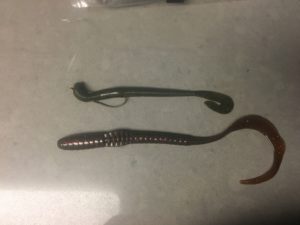 misses. It takes practice to land fish.
misses. It takes practice to land fish.
The second tactic I learned on a hot summer day at Fort A.P. Hill at Reynolds Run Pond. I was on the water several hours and the fish were not taking anything that I was throwing, but I kept hearing fish taking something out on the lily pads. I rigged the hook inside the worm and threw it out on the bed of lily pads without any weight. I slowly retrieved the worm and let it rest once it was on a lily pad. Pickerel and Bass took the worms. I lost a lot of fish that dove and tangled the line in the lily pad roots. The ideal location to target was a lily pad about 5-feet to 10-feet from the edge of the lily pad bed. You will still lose fish but some you may be able to fight out of the roots beneath the surface. You will lose some tackle but losing a hook and a rubber worm is a fair price for the action.
Below are more ideas on rigging artificial worms.
https://mysterytacklebox.com/blog/how-to-rig-soft-plastics/
http://bestbassfishinglures.com/rubber-worms/
http://www.fishing-tips-bait-tackle.com/rubber_worm.html
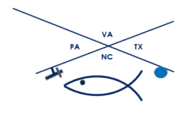 bluecordfishermen
bluecordfishermen 